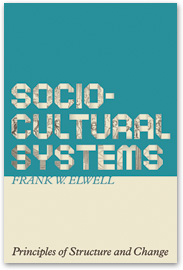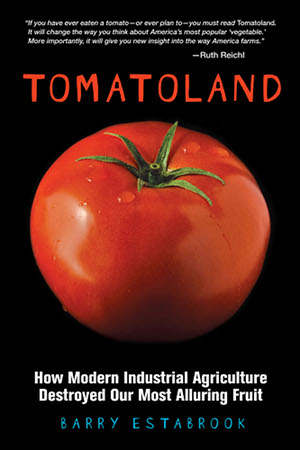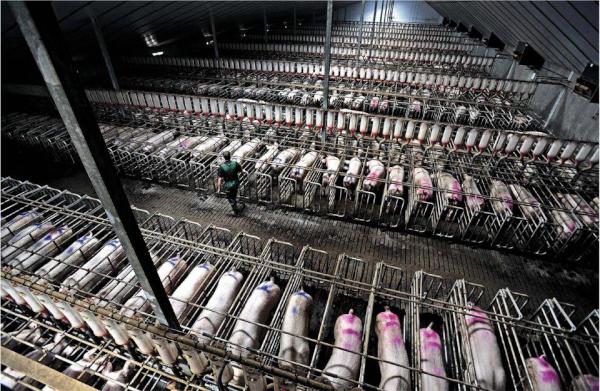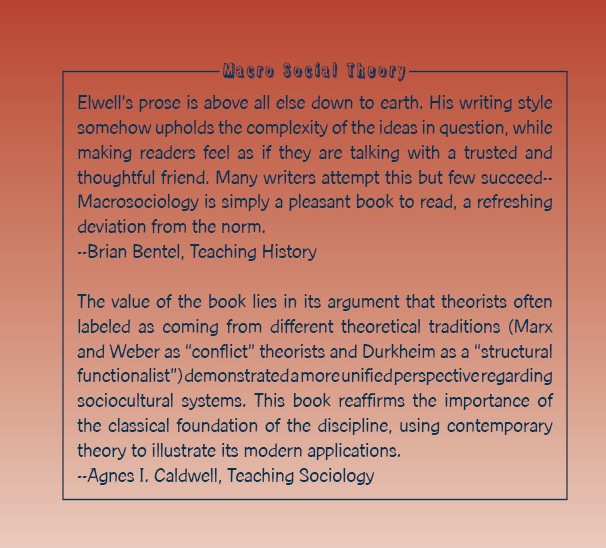
Sociocultural Systems: Principles of Structure and Change Macrosociology: Four Modern Theorists A Commentary on Malthus" 1798 Essay as Social Theory Great Classical Social Theorists In the Classical Tradition: Modern Social Theorists Dr. Elwell's Professional Page
|
Herbert Spencer's Evolutionary Sociology Max Weber [1864-1920] | |
|
The Irrationality Factor (Part 1)
By Frank W. Elwell
Weber makes a distinction between
zweckrational or “formal rationality” and
wertrational or “substantive
rationality.” Weber uses the term “formal rationality” to refer to simple
means-ends rational calculation. You have a goal and you take rational
steps—that is steps that are based on past experience, observation, logic,
or science—to attain that goal. The concept of “substantive rationality,” on
the other hand, refers to goal oriented rational action within the context
of ultimate ends or values. “The concept of ‘substantive rationality,’ on
the other hand, is full of ambiguities. It conveys only one element common
to all ‘substantive’ analyses: namely, that they do not restrict themselves
to note the purely formal and (relatively) unambiguous fact that an action
is based on ‘goal-oriented’ rational calculation with the technically most
adequate methods, but apply certain criteria of ultimate ends whether they
be ethical, political, utilitarian, hedonistic, feudal (standisch),
egalitarian, or whatev
Weber’s rationalization process does not translate well to the American ear.
The term “rationalization” itself is often confused in the American mind
with the more common meaning of giving superficially plausible reasons or
excuses to your behavior that serve to cover up the real causes. The German
term “zweckrational,” defined as goal-oriented rational behavior based on
observation and logic, does not have a good English equivalent. The same
goes for “wertrational,” or goal-oriented rational action in relation to
values or ultimate ends. Weber also used the somewhat simpler terms “formal”
and “substantive” rationality to get at the same contrast in types of
thought.
And so, sociologists like me clunk Weber’s terms into a sentence whole and
continue to hope that we can reach a few. C. Wright Mills tried a different
course. Ignoring Weber’s German terminology, Mills (1959) makes a simple
distinction between rationality and reason. He asserts that by their
participation in bureaucratic organizations individuals lose their ability
to control their own actions and are forced to submit to the rational rules
of the organization. The individual is thereby guided not by her conscious
reason—with all its attendant human emotions, social traditions, and
conflicting values—but rather by the prescribed rationalized rules and
procedures of the organization itself. “It is not too much to say that in
the extreme development the chance to reason of most men is destroyed, as
rationality increases and its locus, its control, is moved from the
individual to the big-scale organization. There is then rationality without
reason. Such rationality is not commensurate with freedom but the destroyer
of it” (170). This middle-course of using colloquial English terms seems
valuable to me, but I do not think Mills chose his terminology wisely. There
is a better way of expressing Weber’s theory of the irrationality of
rationalization in English.
I suggest that formal rationality is better translated into English as
technocratic thinking,
substantive rationality as critical
thinking. Weber’s rationalization theory is that modernity promotes the
growing dominance of technocratic thinking at the expense of critical
thinking; as bureaucracy comes to dominate modern society, it becomes the
dominant motivating force—a mode of thought that becomes part of our very
being. Further, Weber maintained that even though
a bureaucracy is highly rational in the formal sense of technical
efficiency, it does not follow that it is also rational in the substantive
sense of the moral acceptability of its goals or the means used to achieve
them. Nor does an exclusive focus on the goals of the organization
necessarily coincide with the broader goals of society as a whole. It often
happens that the single-minded pursuit of practical goals can actually
undermine the foundations of the organization or even of the social order.
What is good for the bureaucracy in the short-term is not always good for
the society as a whole--and often, in the long term, is not good for the
bureaucracy either. As bureaucracy grows in power and scope around
us, as the social world becomes ever more rationalized, that is as formal
rationalization becomes more prevalent, substantive rationality takes less
and less of a role in human affairs. But still, the precision and punch of
Weber’s rationalization theory often seems to be lost in translation.
Higher education is fond of claiming that one of its major goals is teaching
critical thinking. But critical
thinking is tough to define—one of those qualities that you may know when
you see it but difficult to put into words. I once had to attend a workshop
on critical thinking at my previous university. They brought in a big-name
philosophy professor from Vanderbilt University to run the workshop on a
Saturday, and mandated that all faculty show up for the services. The
professor was giving several definitions of critical thinking, none of which
I really under
Since that time I have done a little research on the issue and found that
the Vanderbilt professor made several errors. First off, it was not a tomato
picker, the correct name is tomato harvester—though I still use the term
picker because that is how I have come to think of it. He
was also in error in that it was not simple problem solving, but a
series of problem solving steps. In fact, the mechanical harvester was the
result of work by “a team made up of an engineering group and a
horticultural group, with advice and assistance from agronomists and
irrigation specialists [that] developed suitable plants and an efficient
harvester at the same time” (Rasmussen 1968, 532-533). To accommodate the
mechanical picker the technologists not only had to develop a tomato that
could withstand a 15 mile and hour impact, but it also had to be resistant
to bruising. As traditional fields were harvested by hand several times as
they ripened, all the tomatoes in the field to be picked mechanically had to
ripen at about the same time as the machine cut the vines below the ground
and would kill the plant with the harvest. As it is not easy to shake a
traditional tomato from its vine the technologists had to develop a variety
that could easily be shaken loose. For fresh tomatoes, rather than those
used for canning or sauces, there were additional problems. Because they
were to be shipped all over the country from California, they had to be
picked green and then gassed in the packing plant so as to turn red during
shipping. 
It should also be pointed out that all this problem solving created
additional problems for people as well. Because mechanical pickers replaced
a lot of manual labor, thousands lost their jobs. Because the machine
required large fields and economies of scale to own and operate a mechanical
tomato picker, many growers had to sell out or go under. Finally, because
California could now supply fresh tomatoes year round for millions of
people, the growers entered into long-term contracts with grocery stores
throughout the country, thus creating national producers and closing markets
for local producers who could only supply tomatoes in season. In other
words, simple problem-solving without placing this problem solving in the
context of the whole, led to the production of year round tomatoes that have
sacrificed a large number of farmers and workers, destroyed many local
markets, and sacrificed the
tenderness and taste of the tomato itself. Other than that, it has been a
complete success.
While problem solving is invaluable, it must be done in a context of values,
traditions, and emotions. Critical thinking attempts to analyze situations
and solve problems within the context of the whole, within the context of
the system. Critical thinking is not really something parents, educators, or
religious leaders can teach directly, it has to be modeled, encouraged, and
developed over time and experience. However, critical thinking is not
conducive to the smooth operation of bureaucracies and is therefore not
widespread in hyper-industrial societies.
Wendell Berry (1977) illustrates how the pursuit of technocratic rationality
can often undermine the very goals of the bureaucracy itself. American
agriculture, Berry writes, has become an extractive industry in which values
of productivity and profit have replaced maintenance and care for the land
and animals. Farms have progressively become rationalized operations
throughout the 20th century. In crop production this
rationalization include
In the last 30 or 40 years rationalization of the farm has been extended
into the area of animal husbandry in which animals are specially bred for
desirable characteristics such as rapid maturity, heavy weight and large
breasts on turkeys and chickens, or resistance to disease and pests. Raised
in large concentrations—chicken sheds, intensive piggeries, and cattle
feedlots containing thousands—the process is aided by mechanized feeding and
waste removal, as well as the liberal administration of drugs to prevent the
spread of disease. Further rationalization of agricultural practices can be
expected as genetic engineering continues to advance.
This rationalization of agriculture has been done at the expense of farm
families and their communities, as well as the wider society. Based on huge
amounts of capital for machinery, land, chemicals, seeds, and fuel,
industrial agri It is the agricultural universities which perhaps best illustrate how the irrationality factor can sometimes undermine the very purpose of the organization itself. Berry (1979) points out that the Morrill Land-Grant College Act was specifically created to assist the farmer. “The land-grant acts gave to the colleges not just government funds and a commission to teach and do research, but also a purpose which may be generally stated as the preservation of agriculture and rural life” (155). However, university agriculture departments single-mindedly pursued the goal of increased productivity above all else. In doing so these institutions actually destroyed the very clients for which they were created to help. For a more extensive discussion of Weber's theories refer to Macro Social Theory by Frank W. Elwell. Also see Sociocultural Systems: Principles of Structure and Change to learn how his insights contribute to a more complete understanding of modern societies.
Elwell, F. 2009.
Macrosociology: The Study of
Sociocultural Systems. Lewiston: Mellen Press.
Elwell, F. W. 2013. Sociocultural
Systems: Principles of Structure and Change.
Alberta: Athabasca University Press.
Weber, M. 1903-1917/1949.
The Methodology of the Social Sciences.
(E. Shils, H. Finch, Eds., E. Shills, & H. Finch, Trans.) New York:
Free Press.
Weber, M. 1904/1930. The Protestant Ethic and the Spirit of
Capitalism. (T. Parsons, Trans.) New York: The Citadel Press.
Weber, M. 1921/1968. Economy and Society. (G. Roth, C.
Wittich, Eds., G. Roth, & C. Wittich, Trans.) New York: Bedminster
Press.
Weber, M. 1927/2003. General
Economic History. (F. Knight, Trans.) Mineola, New York: Dover
Publications, Inc.
Weber, M. 1946/1958. Essays in
Sociology. (H. Gerth and C. Mills, Eds. And Trans.) In M. Weber,
H. Gerth, & C. Mills, From Max Weber. New York: Oxford
University Press.
Referencing this Site: The Irrationality Factor (Part 1) is copyrighted by Frank W. Elwell. Should you wish to quote from this material the format should be as follows: Elwell, Frank, 1996, "The Irrationality Factor (Part 1)" Retrieved June 1, 1999 [use actual date], http://www.faculty.rsu.edu/~felwell/Theorists/Weber/Whome4.htm
Over
|
 er they may be against these scales of ‘value
rationality’ or ‘substantive goal rationality’”(Weber 1921/1968, 85-86).
Substantive rationality is holistic thinking focused upon problem solving
within a system of values as opposed to the specialized, technical thinking
that dominates the age. Bureaucratic organizations, whether of the corporate
or the government variety, are very much based on formal rationality, their
hierarchically ranked offices filled by officers of narrow specialty and
authority guided in their decision making and actions by rules and
precedent.
er they may be against these scales of ‘value
rationality’ or ‘substantive goal rationality’”(Weber 1921/1968, 85-86).
Substantive rationality is holistic thinking focused upon problem solving
within a system of values as opposed to the specialized, technical thinking
that dominates the age. Bureaucratic organizations, whether of the corporate
or the government variety, are very much based on formal rationality, their
hierarchically ranked offices filled by officers of narrow specialty and
authority guided in their decision making and actions by rules and
precedent. 
 stood (he was a philosopher, after all). Finally, I asked him
for an example of critical thinking and this is what he told us: “A man out
in California invented a tomato picker. The picker was designed to cut
tomato vines, shake the tomatoes loose, spray wash them, place them on a
conveyor belt where the poorer quality tomatoes would be removed by hand and
then the conveyor belt would drop them into a wagon that followed. However,
there was a problem: to clear the machine the tomato had to withstand an
impact of 15 miles an hour into the wagon. They tried several adjustments to
the machine but just could not solve the problem. Finally, the Vanderbilt
professor said, a critical thinker came along with the solution: he
developed a tomato that could withstand a 15 mile an hour impact.” Even at
the time I thought that this was a poor example. Rather than critical
thinking it seemed to me to be more an example of problem solving, or what
many would call “technocratic thinking.”
stood (he was a philosopher, after all). Finally, I asked him
for an example of critical thinking and this is what he told us: “A man out
in California invented a tomato picker. The picker was designed to cut
tomato vines, shake the tomatoes loose, spray wash them, place them on a
conveyor belt where the poorer quality tomatoes would be removed by hand and
then the conveyor belt would drop them into a wagon that followed. However,
there was a problem: to clear the machine the tomato had to withstand an
impact of 15 miles an hour into the wagon. They tried several adjustments to
the machine but just could not solve the problem. Finally, the Vanderbilt
professor said, a critical thinker came along with the solution: he
developed a tomato that could withstand a 15 mile an hour impact.” Even at
the time I thought that this was a poor example. Rather than critical
thinking it seemed to me to be more an example of problem solving, or what
many would call “technocratic thinking.” 
 culture promotes the growing concentration of farmland in
order to achieve economies of scale. As a result, those working the land
have become a tiny percentage of the population of industrial societies and
farm communities and small-towns have become almost nonexistent. The driving
force behind this concentration has not been the individual farmer, but
rather the collaboration of agribusiness, government bureaucrats, and
agricultural scientists of higher education that have promoted this
intensification. Consequently, it is their inte
culture promotes the growing concentration of farmland in
order to achieve economies of scale. As a result, those working the land
have become a tiny percentage of the population of industrial societies and
farm communities and small-towns have become almost nonexistent. The driving
force behind this concentration has not been the individual farmer, but
rather the collaboration of agribusiness, government bureaucrats, and
agricultural scientists of higher education that have promoted this
intensification. Consequently, it is their inte